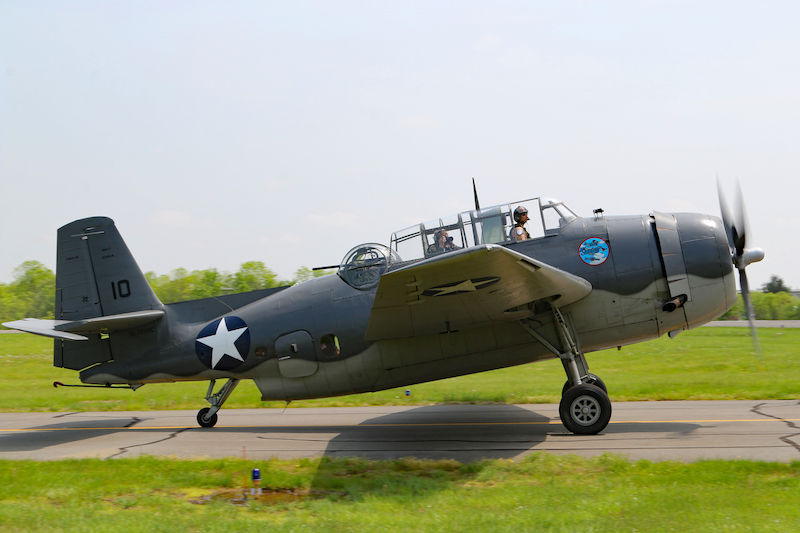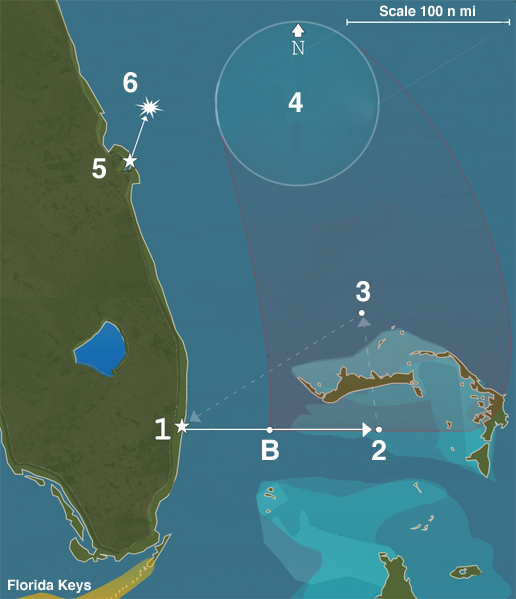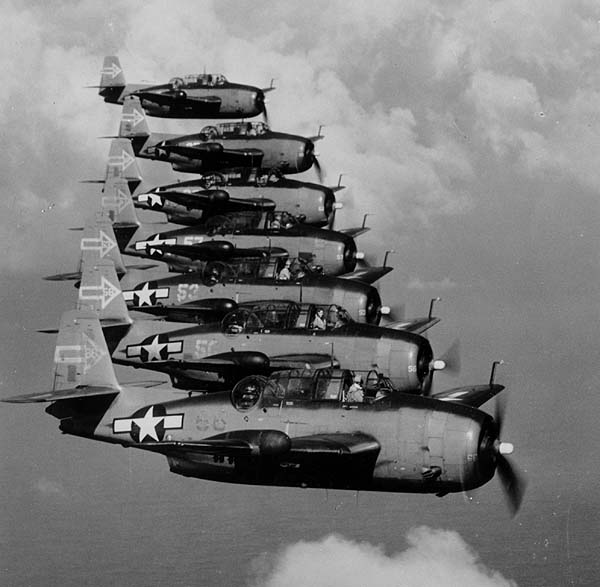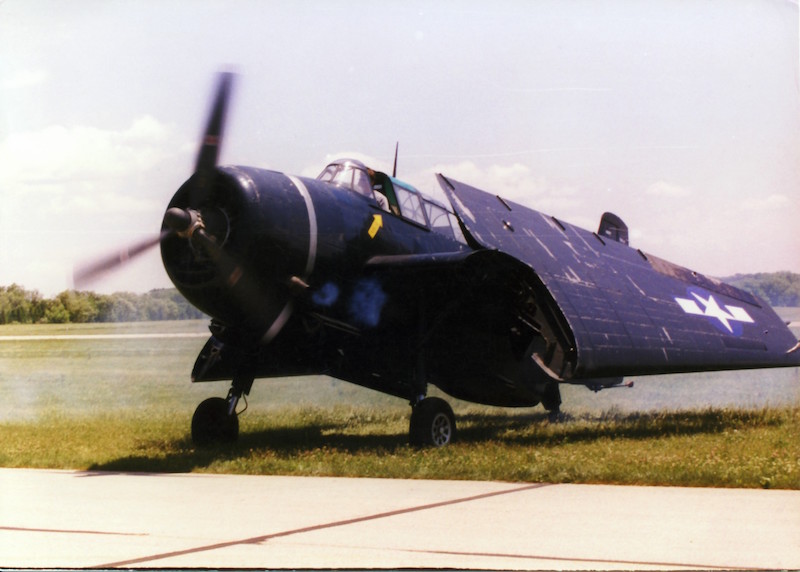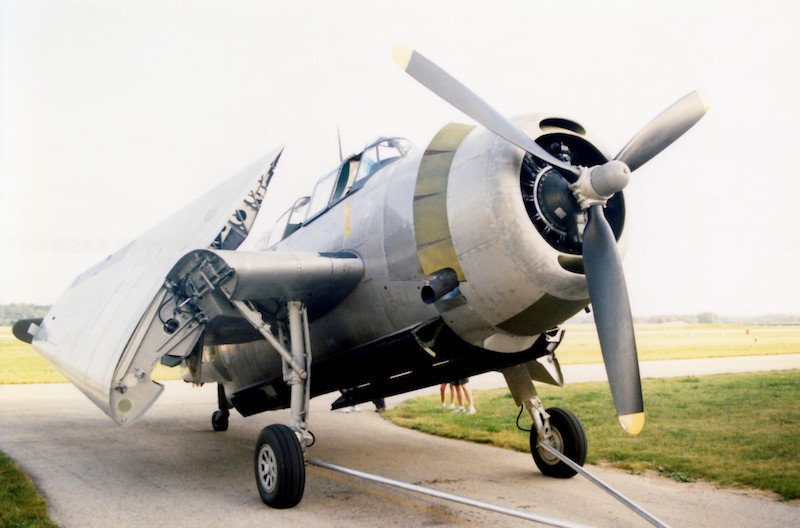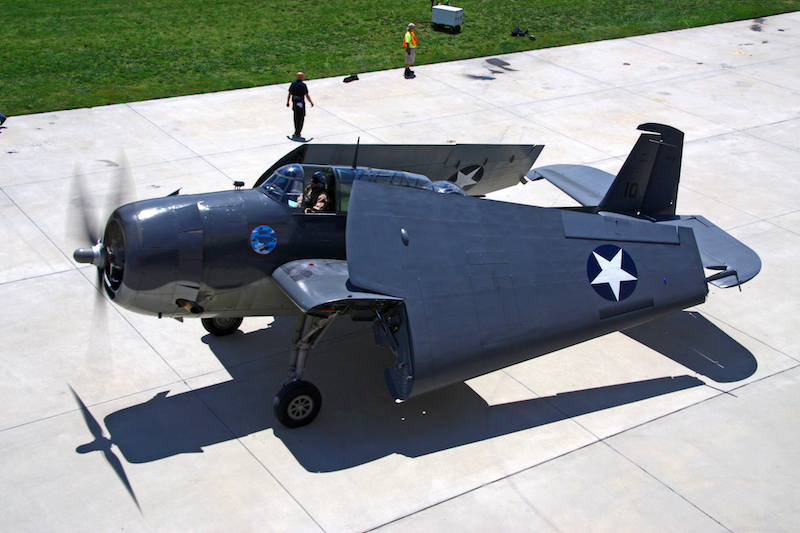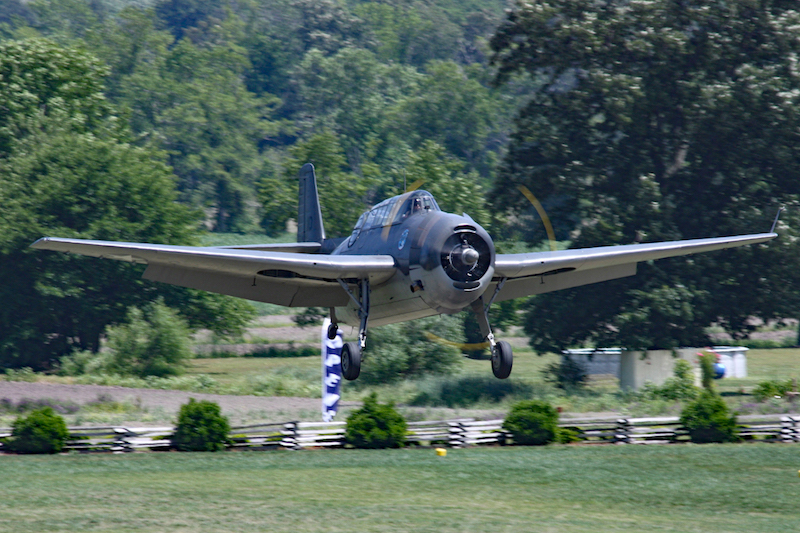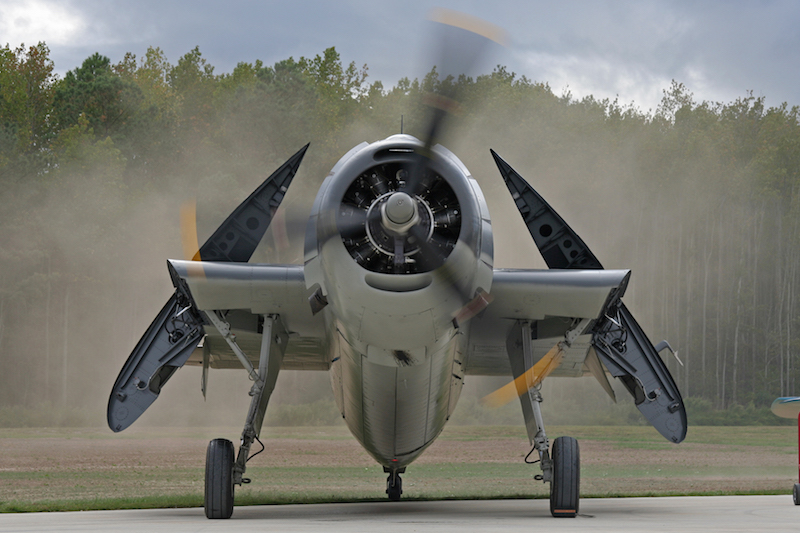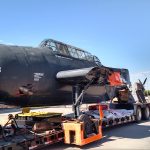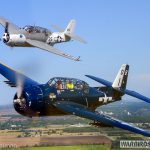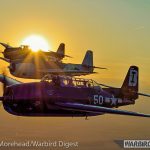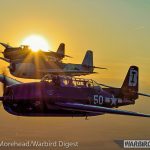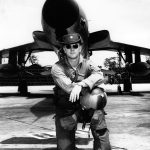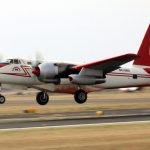By Stephen Chapis
In December 1945, five TBM Avengers and 14 aircrew members vanished on a routine navigation training flight in the infamous Bermuda Triangle. Almost 60 years later Military Aviation Museum (MAM) pilot Obie O’Brien flew TBM-3E Avenger BuNo 53454 into this mythical and mysterious piece of airspace- and lived to tell the tale.
FLIGHT 19- THE LOST PATROL
On December 5, 1945, a flight of five TBM Avengers, four TBM-1Cs, and one TBM-3, took off from NAS Fort Lauderdale, Florida on an overwater navigation training flight entitled Navigation Problem #1. It was a straightforward flight that had been flown dozens of times before by other flights, including one earlier that morning.
The flight plan called for the aircraft to depart Fort Lauderdale, fly 091 degrees for 56 miles and conduct 30 minutes of low-level bombing practice at Hens and Chickens Shoals and then continue on course 091 for another 67 miles. At this point, they would turn on a northerly heading of 346 for 73 miles then turn to 241 degrees for the return leg to Fort Lauderdale. What should have been a 2-hour training flight became a flight into oblivion that forever cemented Flight 19 in the legend and mystery of the Bermuda Triangle.
In the 72 years since this tragedy occurred, there have been many theories put forth as to what caused the five TBMs to become lost and forever swallowed by the sea. These theories range from straightforward equipment failure and pilot disorientation to preposterous claims of extraterrestrials and supernatural powers. Whatever the cause; the radio transmissions from the flight members like- “cannot see land”, “we can’t find west”, “everything is wrong”, and the final call of “…it looks like we are entering white water…..we’re completely lost” all tell a chilling tale of desperate men flying through a darkening sky and deteriorating weather. The scope of this article is not to rehash the facts and myths in the disappearance of Flight 19, but to tell the history of one TBM pilot who flew into the Bermuda Triangle.
EASTERN AIRCRAFT TBM-3E AVENGER- BuNo 53454
The Avenger torpedo bomber was one of the largest single-engine combat aircraft of WWII. In fact, it was so big (How big was it?!) that it could not be built under a single roof once General Motors Eastern Aircraft Division took overproduction. The plant in Baltimore, Maryland produced the tail sections, the electrical and hydraulic systems were manufactured in Bloomfield, New Jersey, and the Tarrytown, New York facility built the cockpits and wings. The finished subassemblies were shipped to the final assembly line in Trenton, New Jersey.
Many of the aircraft in the Military Aviation Museum (MAM) collection have a direct connection with the Virginia Beach area and the TBM-3E Avenger is no different. The aircraft was accepted by the U.S. Navy on May 26, 1945, and was assigned BuNo 53454. The aircraft’s early history is a little sketchy, but by December 1950 the TBM was assigned to Anti-Submarine Squadron Twenty-Two (VS-22) “Checkmates” at NAS Norfolk, Virginia. When VS-22 converted to the Grumman AF-2S Guardian in February 1952, 53454 was transferred to VS-801 “Diamond Cutters” also based at Norfolk. The Avenger deployed aboard the USS Palau (CVE-122) from April through July 1952 when the carrier sailed into the Med with the Sixth Fleet. After this cruise, the squadrons Avengers were once again replaced by the Guardian. In late 1952 the aircraft went through the maintenance facilities at Norfolk and Corpus Christi before being assigned to a training squadron at NAS Kingsville, Texas on January 27, 1953. In February 1954 the Avenger was retired to the storage facility at Litchfield Park, Arizona. It was stricken from Navy records on May 31, 1956, with 1,227 hours total time.
On January 18, 1957, Ralph Richardson, president of Yakima, Washington-based Richardson Airways, purchased the Avenger for just over $4,300. Assigned the registration number N7030C the TBM went into the shop for an extensive conversion to a spray aircraft. A major portion of this conversion involved the removal of all military equipment and the installation of an 800-gallon tank in the bomb bay. The associated plumbing system was driven by a hydraulic motor attached to the engine’s accessory section. Spray booms extending from the trailing edges of the wings with each boom containing 15 spray nozzles. For normal operations the system was activated by an electric switch on the stick, in an emergency pulling a handle on the left side of the cockpit would empty the tank in 20 seconds. On April 26, 1958, the aircraft was flight tested by Gerald Wilson with a payload of 6,400lbs.
From 1958 through 1962 Three Zero Charlie served with three other spray companies in Oregon and Washington. In June 1962 it was purchased by Idaho Air Tankers of Boise, Idaho, and began its career as a fire bomber. It flew with this outfit until October 1965 when it was purchased by Charles Reeder of Reeder Flying Services. The TBM was operated by this Twin Falls, Idaho-based outfit as Tanker #13 until 1984. Its Reeder paint scheme was natural metal with yellow trim, and black #13 on the vertical tail and cowl.
In 1986, the Avenger was acquired by the Naval Aviation Museum in Pensacola, Florida where it remained until it was acquired by David Tallichet’s Military Aircraft Restoration Group in Anaheim, California. When the aircraft was purchased by Gary Applebaum in September 1998 the aircraft had been parked in Rockford, Illinois for quite some time. Gary says that even though it was in rough shape the TBM was still an impressive aircraft.
Gary hired Sam Pedro to go down to Rockford and work to get the Avenger so it could be ferried to East Troy, Michigan where the aircraft was given a cosmetic restoration and overhaul, which included metalwork, recovering control surfaces, replacing all the hoses, and overhauling the prop. Gary says the last time the engine was overhauled was 1953 while the Avenger was still in the Navy and other than replacing one cylinder and a couple of valves the big Wright was still strong. During his ownership, Gary became acquainted with Richard “Zeke” Cormier, who flew 75 missions in TBF-1Cs off USS Card (CVE-11) in the Atlantic. Later in the war, Cormier transferred to the Pacific, flying an additional 61 missions in F6Fs, and was credited with 8 Japanese aircraft destroyed and 2 probable. For his actions during the war, Zeke earned five Distinguished Flying Crosses, a Silver Star, and eight Air Medals. In 1953 Cormier became the leader of the Blue Angels and directed the team’s transition from Panthers to Cougars. After learning of the accomplishments of this legendary career naval aviator Gary decided to paint the Avenger in the markings of Cormier’s aircraft from Composite Squadron One.
In 2001, the TBM was acquired by Gerald Yagen and has been displayed at airshows up and down the eastern seaboard for many years. In recent years the aircraft has participated in many naval commemorative flyovers in the Virginia Beach and Norfolk area. These include the commissioning of USS George H.W. Bush (CVN-77) in January 2009, which seems quite apropos since the 41st President of the United States is the world’s most famous Avenger pilot. In the years that followed ‘454 participated in flyovers at the Virginia Beach Veterans Memorial and the Midway commemoration at NAS Oceana in May and June 2011 respectively.
However, the MAM Avenger will probably be most remembered for is when Josh Wilson broke out of formation during the Arsenal of Democracy flyover on May 8, 2015. Just as Wilson was making the turn to fly down the National Mall, a high-pressure hydraulic leak developed in the radio compartment. At the time Wilson thought he heard the word “FIRE!”, and he immediately broke right out of formation. This break put him on short final for Runway 19 at Reagan National. Wilson made a flawless landing and once the aircraft came to a stop he and his two passengers exited the aircraft with great haste. The leak turned out to be a simple fix and the TBM was flown back to Culpeper that evening and Josh and his passengers had one hell of a hangar story.
INTO THE TRIANGLE
In July 1976, Commander Charles Joseph O’Brien, universally known as Obie, retired from the United States Navy after nearly 30 years of service. During his career as a naval aviator, he logged over 7,000 hours and 625 carrier landings on 20 different carriers in aircraft ranging from the 150mph SNJ to Mach 1.8-capable F8U-1P Crusader. Highlights in his career included 22 combat missions over Korea in F4U-4 Corsairs and photo missions over Cuba and the Middle East in the F8U-1P.
In 1980, Obie was invited to fly with the Miller High Life Squadron (now Geico Skytypers) and stayed with the team until he retired from the squadron in 2004. In 2001, Obie was introduced to Gerald Yagen and his Fighter Factory group and soon began flying the SNJ-4, L-5, PT-17, Chipmunk, T-34, TBM, AD-4, and FG-1D.
In 2004, National Geographic contacted Yagen about using his beautifully restored General Motors TBM-3E Avenger and a pilot for an episode of Naked Science that centered on the Bermuda Triangle. Obie immediately volunteered for the job simply because flying an Avenger to Florida and back sounded like a lot of fun. On May 25, 2004, Obie took off for the 5-hour flight down to Fort Lauderdale-Hollywood Airport, with an en-route fuel stop in Glencoe, Georgia. The weather along the entire route was CAVU. The next morning Obie met with the seven-man British production crew. While the crew spent several hours installing the cameras around the aircraft, Obie and the pilot of the PA-32 Saratoga photo plane briefed the flight.
Obie recalled the flight in a 2011 interview with the author, “I was to navigate by dead reckoning just as the original flight was briefed to do, but I did slip a small GPS in my pocket…just in case. We took off at 1410hrs the same time as the lost flight; I had a very nervous director and soundman in the airplane with me. Flying at 1,500 feet we were just under the base of some scattered clouds, it was a great day for flying. My first checkpoint came up in about 45 minutes and I made my turn to the northwest and for some reason, I recalled what my dear wife, Barbara, said just before I left the house. She said, “Do you actually think that a 76-year-old man flying a 63-year-old airplane way out over the ocean is a very smart thing to do?” Obie says if he had chosen to answer he would have said “Hell yes!”, but he’s a lot smarter than that.
It was just after Flight 19 made their turn to 346 degrees that their situation started to deteriorate, but for Obie, the flight was going quite smooth. He continues, “Grand Bahama came into view on schedule, and a little while after I made my turn to 241 degrees for the last leg back to Fort Lauderdale. It was right where I had left it 2 hours ago! It was a great flight that I thoroughly enjoyed. I never saw any UFOs.”
As a career Naval Aviator Obie doesn’t believe in all the supernatural theories that were the cause of Flight 19s disappearance. His take is fairly simple- “I would guess that if they flew northeast because the instructor thought he was over the Keys they simply ran out of gas somewhere out there.” During the flight back to Virginia Obie said the Avenger suffered a complete radio failure. Hmm, leftover gremlins from the Bermuda Triangle? Maybe.







